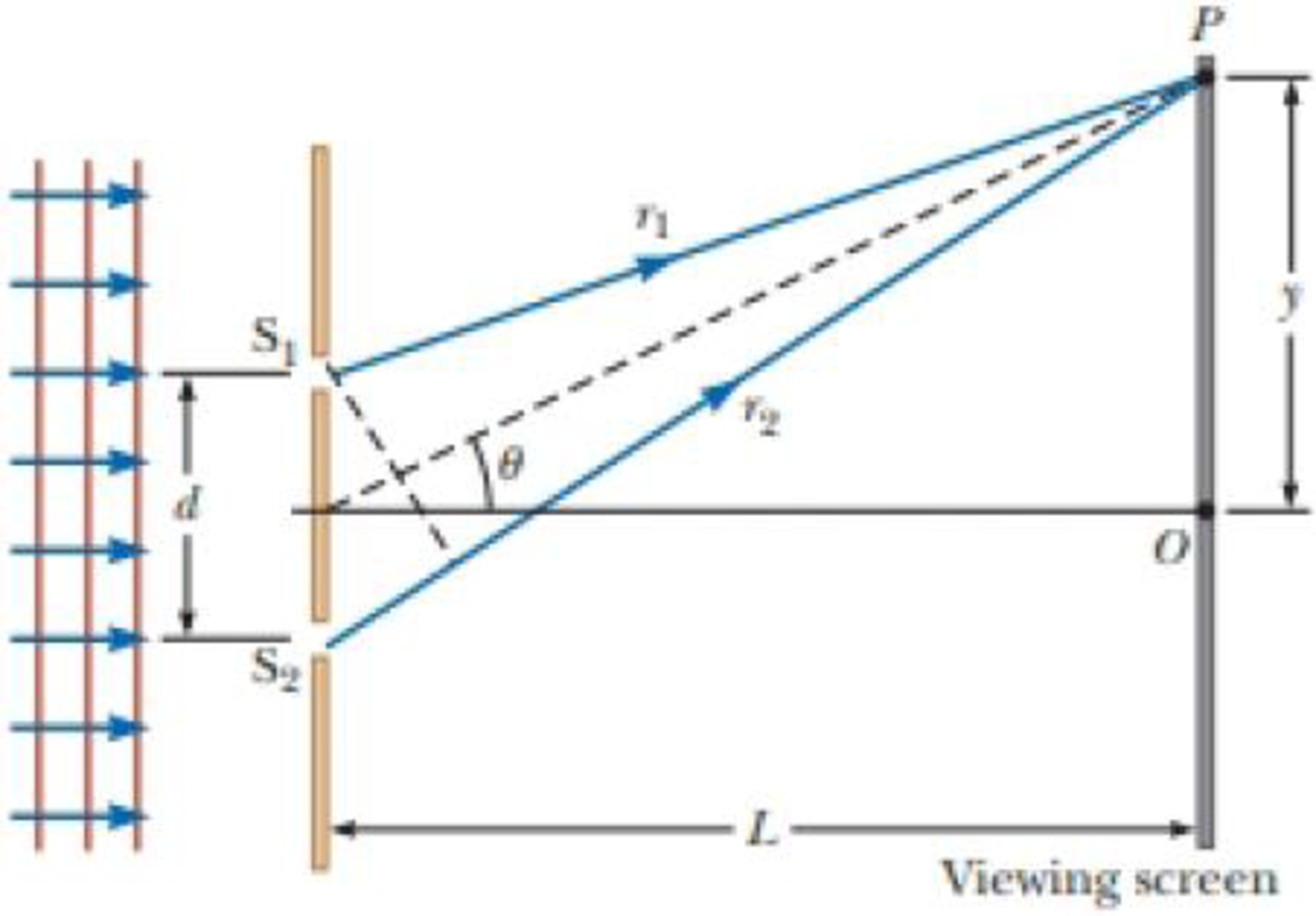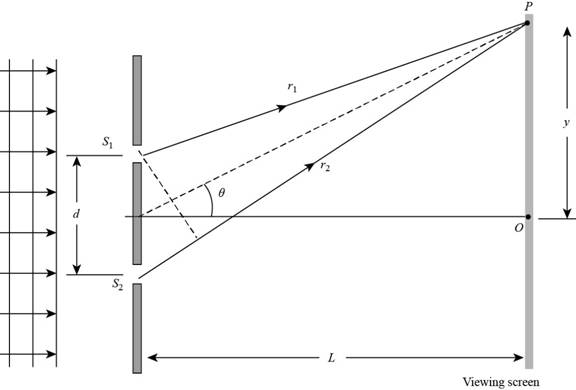
Concept explainers
In Figure P36.10 (not to scale), let L = 1.20 m and d = 0.120 mm and assume the slit system is illuminated with monochromatic 500-nm light. Calculate the phase difference between the two wave fronts arriving at P when (a) θ = 0.500° and (b) y = 5.00 mm. (c) What is the value of θ for which the phase difference is 0.333 rad? (d) What is the value of θ for which the path difference is λ/4?
Figure P36.10

(a)
The phase difference between the two waves fronts arriving at
Answer to Problem 10P
The phase difference between the two waves fronts arriving at
Explanation of Solution
Given info: The separation between the slits is
The given diagram is shown below.

Figure 1
The formula to calculate the phase difference is,
Here,
Substitute
Conclusion:
Therefore, the phase difference between the two waves fronts arriving at
(b)
The phase difference between the two waves fronts arriving at
Answer to Problem 10P
The phase difference between the two waves fronts arriving at
Explanation of Solution
Given info: The separation between the slits is
The formula to calculate the phase difference is,
Here,
From the right angle triangle
Here,
Substitute
Substitute
Conclusion:
Therefore, the phase difference between the two waves fronts arriving at
(c)
The value of
Answer to Problem 10P
The value of
Explanation of Solution
Given info: The separation between the slits is
The formula to calculate the phase difference is,
Here,
Rearrange the above formula to find
Substitute
Conclusion:
Therefore, the value of
(d)
The value of
Answer to Problem 10P
The value of
Explanation of Solution
Given info: The separation between the slits is
The formula to calculate the phase difference is,
Here,
The path difference is
Substitute
Rearrange the equation (1) to find
Substitute
Conclusion:
Therefore, the value of
Want to see more full solutions like this?
Chapter 36 Solutions
Physics for Scientists and Engineers with Modern Physics
- Help me make a visualize experimental setup using a word document. For the theory below.arrow_forwardHow to solve this, given answerarrow_forwardThree point-like charges are placed at the corners of a square as shown in the figure, 28.0 cm on each side. Find the minimum amount of work required by an external force to move the charge q1 to infinity. Let q1=-2.10 μC, q2=+2.40 μС, q3=+3.60 μC.arrow_forward
- A point charge of -4.00 nC is at the origin, and a second point charge of 6.00 nC is on the x axis at x= 0.820 mm . Find the magnitude and direction of the electric field at each of the following points on the x axis. x2 = 19.0 cmarrow_forwardFour point-like charges are placed as shown in the figure, three of them are at the corners and one at the center of a square, 36.0 cm on each side. What is the electric potential at the empty corner? Let q1=q3=+26.0 µС, q2=-28.0 μC, and q4=-48.0μc Varrow_forwardPLS HELparrow_forward
 Principles of Physics: A Calculus-Based TextPhysicsISBN:9781133104261Author:Raymond A. Serway, John W. JewettPublisher:Cengage Learning
Principles of Physics: A Calculus-Based TextPhysicsISBN:9781133104261Author:Raymond A. Serway, John W. JewettPublisher:Cengage Learning Physics for Scientists and Engineers: Foundations...PhysicsISBN:9781133939146Author:Katz, Debora M.Publisher:Cengage Learning
Physics for Scientists and Engineers: Foundations...PhysicsISBN:9781133939146Author:Katz, Debora M.Publisher:Cengage Learning Physics for Scientists and Engineers with Modern ...PhysicsISBN:9781337553292Author:Raymond A. Serway, John W. JewettPublisher:Cengage Learning
Physics for Scientists and Engineers with Modern ...PhysicsISBN:9781337553292Author:Raymond A. Serway, John W. JewettPublisher:Cengage Learning Physics for Scientists and EngineersPhysicsISBN:9781337553278Author:Raymond A. Serway, John W. JewettPublisher:Cengage Learning
Physics for Scientists and EngineersPhysicsISBN:9781337553278Author:Raymond A. Serway, John W. JewettPublisher:Cengage Learning Glencoe Physics: Principles and Problems, Student...PhysicsISBN:9780078807213Author:Paul W. ZitzewitzPublisher:Glencoe/McGraw-Hill
Glencoe Physics: Principles and Problems, Student...PhysicsISBN:9780078807213Author:Paul W. ZitzewitzPublisher:Glencoe/McGraw-Hill University Physics Volume 3PhysicsISBN:9781938168185Author:William Moebs, Jeff SannyPublisher:OpenStax
University Physics Volume 3PhysicsISBN:9781938168185Author:William Moebs, Jeff SannyPublisher:OpenStax





